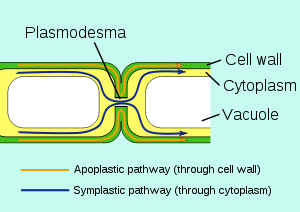Symplast

The symplast of a plant is the inner side of the plasma membrane in which water and low-molecular-weight solutes can freely diffuse.
The plasmodesmata allow the direct flow of small molecules such as sugars, amino acids, and ions between cells. Larger molecules, including transcription factors and plant viruses, can also be transported through with the help of actin structures.
This allows direct cytoplasm-to-cytoplasm flow of water and other nutrients along concentration gradients. In particular, symplastic flow is used in the root systems to bring in nutrients from soil. It moves these solutes from epidermis cells through the cortex into the endodermis. Once solutes reach the endodermal cells thorough apoplastic flow, they are forced into the symplastic pathway due to the presence of the Casparian strip. Once the solutes are passively filter ed, they eventually reach the pericycle, where it can be moved into the xylem for long distance transport. It is contrasted with the apoplastic flow, which uses cell wall transport.[1]
History
The symplastic transport was first realized by Eduard Tangl in 1879, who also discovered the plasmodesmata, a term coined by Eduard Strasburger, 1901.[2][3] In 1880, Hanstein coined the term symplast.[4] The contrasting terms apoplast and symplast were used together in 1930 by Münch.[5][6]
References
- ↑ Freeman, Scott (2014). Biological Science. Boston: Benjamin Cummings. ISBN 9780321743671.
- ↑ Tangl, E. (1879). Ueber offene Communicationen zwischen den Zellen des Endosperms einiger Samen. Jahrbüecherfüer Wissenschaftliche Botanik 12: 170–190.
- ↑ Strasburger, E. (1901). Über plasmaverbindungen pflanzlicher zellen. Jahrbücher für Wissenschaftliche Botanik 36: 493–610.
- ↑ Hanstein, J. 1880. Das Protoplasma. Heidelberg.
- ↑ Münch, E (1930). Die Stoffbewegungen in der Pflanze. Verlag von Gustav Fischer, Jena.
- ↑ Pickard, W. F. (2003). The role of cytoplasmic streaming in symplastic transport. Plant, Cell & Environment 26: 1-15, .
See also
- Apoplast
- Plant sap
- Polar auxin transport, a type of cell-to-cell transport
- Protoplast
- Tonoplast